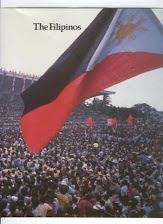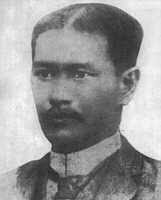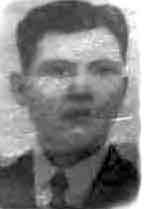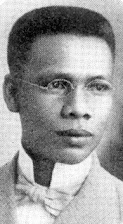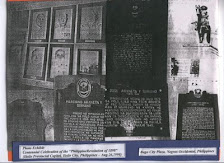Ang Republika Federal sg Kabisay-an (The Federal Republic of the Visayas)
Historical Facts obviously omitted or deliberately hidden in our School History Books
(Source: History Reborn"The Federal Republic of the Visayas" -by: dinggol a.divinagracia*June 12, 2007)
*That Spain had already formally surrendered to the Federal Republic of the Visayas even before Gen. Emilio Aguinaldo was proclaimed Philippine President in Malolos, Bulacan on January 23, 1899. That our Independent Visayan Republic, had never been under the authority and jurisdiction of Aguinaldo's "Katagalogan" Republic in Luzon.
excerpted: "...A paper written by Jose Manuel Velmonte, a research associate at the UP Third World Studies Center, found that the Visayan revolutionary elites not only had sophisticated political ideas but also resented attempts by Malolos to assert its authority. A Tagalog military expedition sent by Malolos to Panay to assert its presence was met with hostility. The Luzon force led by Generals Ananias Diocno and Leandro Fullon was regarded by the Visayan revolutionaries, led by the Visayan supremo, Gen. Martin Delgado, as an ''invasion'' force ..." (Source: Inquirer-1999- 06-13 "View of revolt in provinces spurs revision" By: Amando Doronila)
According to Dr. Luis C.Dery, an eminent Filipino Scholar: "Expounding the extent of Aguinaldo's Philippine Army; the Bangsamoro nation's Mindanao, Sulu, and the rest of its islands never fell under Aguinaldo's politico-military control and sovereignty. In fact as late as August 1898 much of northern Luzon, southern Luzon, the Visayas, and Mindanao remained outside of the control of Aguinaldo's Republic. Thus, several military expeditions were sent to these places to bring' them to recognize the First Philippine Republic."
*That the 1898 Treaty of Paris preliminaries, should not have included territories of the sovereign "Visayan Nation"; the confederation of both the Central and Western Visayas Cantonal Governments by virtue of Spain's formal surrender prior to this U.S. and Spain treaty of peace (Paris) and the $20-million buy-out. Spain had no more legal rights to sell. In legal parlance "nemodat quod non habet” -meaning “you cannot give what is not yours”. It states that the purchase of a possession from someone who has no ownership right to it also denies the purchaser any ownership title.
This diplomatic "Faux pas" that was supposed to be officially consummated and became legal and internationally binding only on APRIL 11, 1899 should, or rather must be rectified.
~~~~~~~~~~~~~~~~~~~~~~~~~~~~~~~
*June 12, 1898 -Gen. Emilio Aguinaldo proclaimed Philippine Independence from Spain in Kawit, Cavite --but never won the war against Spain, as explained in the infamous betrayal --the "Mock Battle of Manila of August 13, 1898".
*Nov. 6 & Dec. 23, 1898 -Spain formally surrendered to both; the Negros Republic that merged (Dec. 2, 1898) with the Federal Republic of the Visayas based in Iloilo (respectively)
excerpted: "...These two nations, from a purely legal point of view, are COMPLETELY LEGITIMATE UNTIL TODAY. This could imply that the Manila-based Tagalista-oriented Unitarian central government of the Philippines in the Visayas and Mindanao is an Occupational Government, that ultimately originated from an invalid Treaty of Paris...."
Dr. Jose P. Dacudao; National President -Save Our Languages thru Federalism Foundation (SOLFED), Inc.
*July 4, 1946 -The United States of America granted Philippine Independence on a silver platter with strings attached.
"True Independence could never be just self-proclaimed nor bestowed upon, it has to be won and duly achieved with dignity" -- DinggolAranetaDivinagracia (Founder: Ilonggo Nation Movement (INM) Global Network ..Dec. 25, 2005)
Dinggol is an Ilonggo Historian of modern times. He is a lover of nature and reform activist by profession; a genealogist by avocation, and an avid advocate of the Cooperative Movement and "Parliamentary" Federalism. He is, likewise, a duly registered Researcher at the U.S. Library of Congress in the nations capital --Washington D.C.
"It is rather speculative as it is without basis of history if we mean of "history" is that which had been written for us by the "tutas" or lackeys of our colonial and imperial masters.." -- Benjie Evicner Estuche (INM Co-Founder)
"Federalism is not the best way, it is the only way"..
~~~~~~~~~~~~~~~~~oo0oo~~~~~~~~~~~~~~
Join the Last Laugh with us!
*When Christopher Columbus said that the world is round, people asked -What? and then they laughed.
*When the Wright brothers said they'll fly and soar the skies, people asked -How? and then they laughed.
*When Jules Verne wrote someday man could travel below the seven seas and shall walk on the moon, people asked - When? and then they laughed.
*When John the Baptist prophesied the coming of the Lord, the Messiah, people asked -Who? and then they laughed.
*When the Ilonggo Nation Movement (INM) Global Network announced its mission and vision, people did not even bother to ask, What? How? When? or Who? --They just laughed and laughed. *People are still laughing, ...but the laughter is fading!
Ang inyo alagad sa guihapon -DinggolAranetaDivinagracia~~
(Source: History Reborn"The Federal Republic of the Visayas" -by: dinggol a.divinagracia*June 12, 2007)
*That Spain had already formally surrendered to the Federal Republic of the Visayas even before Gen. Emilio Aguinaldo was proclaimed Philippine President in Malolos, Bulacan on January 23, 1899. That our Independent Visayan Republic, had never been under the authority and jurisdiction of Aguinaldo's "Katagalogan" Republic in Luzon.
excerpted: "...A paper written by Jose Manuel Velmonte, a research associate at the UP Third World Studies Center, found that the Visayan revolutionary elites not only had sophisticated political ideas but also resented attempts by Malolos to assert its authority. A Tagalog military expedition sent by Malolos to Panay to assert its presence was met with hostility. The Luzon force led by Generals Ananias Diocno and Leandro Fullon was regarded by the Visayan revolutionaries, led by the Visayan supremo, Gen. Martin Delgado, as an ''invasion'' force ..." (Source: Inquirer-1999- 06-13 "View of revolt in provinces spurs revision" By: Amando Doronila)
According to Dr. Luis C.Dery, an eminent Filipino Scholar: "Expounding the extent of Aguinaldo's Philippine Army; the Bangsamoro nation's Mindanao, Sulu, and the rest of its islands never fell under Aguinaldo's politico-military control and sovereignty. In fact as late as August 1898 much of northern Luzon, southern Luzon, the Visayas, and Mindanao remained outside of the control of Aguinaldo's Republic. Thus, several military expeditions were sent to these places to bring' them to recognize the First Philippine Republic."
*That the 1898 Treaty of Paris preliminaries, should not have included territories of the sovereign "Visayan Nation"; the confederation of both the Central and Western Visayas Cantonal Governments by virtue of Spain's formal surrender prior to this U.S. and Spain treaty of peace (Paris) and the $20-million buy-out. Spain had no more legal rights to sell. In legal parlance "nemodat quod non habet” -meaning “you cannot give what is not yours”. It states that the purchase of a possession from someone who has no ownership right to it also denies the purchaser any ownership title.
This diplomatic "Faux pas" that was supposed to be officially consummated and became legal and internationally binding only on APRIL 11, 1899 should, or rather must be rectified.
~~~~~~~~~~~~~~~~~~~~~~~~~~~~~~~
*June 12, 1898 -Gen. Emilio Aguinaldo proclaimed Philippine Independence from Spain in Kawit, Cavite --but never won the war against Spain, as explained in the infamous betrayal --the "Mock Battle of Manila of August 13, 1898".
*Nov. 6 & Dec. 23, 1898 -Spain formally surrendered to both; the Negros Republic that merged (Dec. 2, 1898) with the Federal Republic of the Visayas based in Iloilo (respectively)
excerpted: "...These two nations, from a purely legal point of view, are COMPLETELY LEGITIMATE UNTIL TODAY. This could imply that the Manila-based Tagalista-oriented Unitarian central government of the Philippines in the Visayas and Mindanao is an Occupational Government, that ultimately originated from an invalid Treaty of Paris...."
Dr. Jose P. Dacudao; National President -Save Our Languages thru Federalism Foundation (SOLFED), Inc.
*July 4, 1946 -The United States of America granted Philippine Independence on a silver platter with strings attached.
"True Independence could never be just self-proclaimed nor bestowed upon, it has to be won and duly achieved with dignity" -- DinggolAranetaDivinagracia (Founder: Ilonggo Nation Movement (INM) Global Network ..Dec. 25, 2005)
Dinggol is an Ilonggo Historian of modern times. He is a lover of nature and reform activist by profession; a genealogist by avocation, and an avid advocate of the Cooperative Movement and "Parliamentary" Federalism. He is, likewise, a duly registered Researcher at the U.S. Library of Congress in the nations capital --Washington D.C.
"It is rather speculative as it is without basis of history if we mean of "history" is that which had been written for us by the "tutas" or lackeys of our colonial and imperial masters.." -- Benjie Evicner Estuche (INM Co-Founder)
"Federalism is not the best way, it is the only way"..
~~~~~~~~~~~~~~~~~oo0oo~~~~~~~~~~~~~~
Join the Last Laugh with us!
*When Christopher Columbus said that the world is round, people asked -What? and then they laughed.
*When the Wright brothers said they'll fly and soar the skies, people asked -How? and then they laughed.
*When Jules Verne wrote someday man could travel below the seven seas and shall walk on the moon, people asked - When? and then they laughed.
*When John the Baptist prophesied the coming of the Lord, the Messiah, people asked -Who? and then they laughed.
*When the Ilonggo Nation Movement (INM) Global Network announced its mission and vision, people did not even bother to ask, What? How? When? or Who? --They just laughed and laughed. *People are still laughing, ...but the laughter is fading!
Ang inyo alagad sa guihapon -DinggolAranetaDivinagracia~~
Claim your birth right,
VISIT AND JOIN US! AT: "GLIMPSES OF ILONGGO HISTORY"
https://www.facebook.com/groups/2470058109983695
~~~~~~~~~~~~~~~oo0oo~~~~~~~~~~~~~~~~~~
"ACTA DE CAPITULACION~1898" (The Formal Surrender Document)
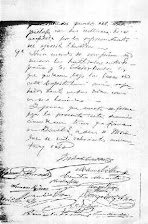
*Nov. 6 & Dec. 23, 1898 -Spain formally surrendered to both; the Negros Republic that merged (Dec. 2, 1898) with the Federal Republic of the Visayas based in Iloilo (respectively)
Ergo! we won our battle-scarred freedom and legitimate independence and became a sovereign nation. The "First" Republic in the whole of Asia, but was nipped-in-the bud by the "ugly" Americans. A diplomatic faux pas, a political blunder and a travesty of history! --DinggolAranetaDivinagracia~~~
===============================================================
===============================================================
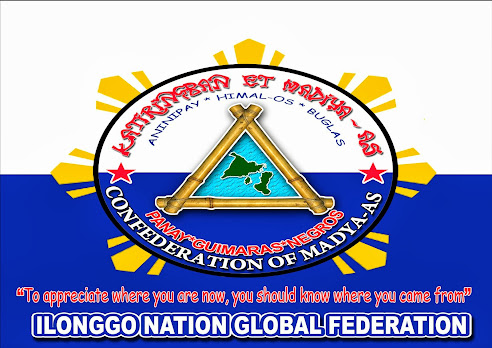
Thursday, October 10, 2019
Friday, October 04, 2019
The Forgotten Ilonggo Revolutionary Leader of 1898
The Forgotten Ilonggo Revolutionary Leader of 1898
(By DinggolAranetaDivinagracia - IlonggoNationMovement)
Hen. Roque Haplasca Lopez, “El Primer Presidente del Estado Federal de Bisayas”

Prologue: “While so many NHI historical markers and concrete monuments; more than life-size statues and bust; textbooks and magazines; main thoroughfares and remote places; and public plazas, schools and government buildings, etc. --were named to honor Don Eustaquio Hechanova Lopez first cousin, the Ilonggo National Hero named Graciano Lopez Jaena, none whatsoever in memory of the Don’s son Roque H. Lopez” --dinggol.d~~~
Brief Backgrounder:
At the turn of the 19th century, Maximo Lopez of Jaro, Iloilo City married Juana Hilaria. They had two sons; Fermin and Placido. Fermin married Fernanda Hechanova while Placido married Maria Jacobe Jaena, the parents of Graciano Lopez Jaena.
On the other hand, Maximo and Juana Hilaria-Lopez' eldest son Fermin who married Fernanda Hechanova were the parents of Eustaquio Hechanova Lopez who later acquired large tracts of land in Negros island and finally settled in Silay, Negros Occidental. The Barangay E. Lopez in Silay City used to be one of his Haciendas in Negros. Don Eustaquio financed his first cousin Graciano's trip to Spain in 1880 that would change the course of Philippine history.
Don Eustaquio Hechanova Lopez, first married Justina Haplasca with whom he had a son named Roque. When the Don became a widower, he remarried for the second and later for the third time in Negros.
Meanwhile, Roque H. Lopez who remained in Iloilo, would later join the "Comite de Conspiradores" of Parian (Molo) and expended his inheritance to finance the revolution of 1898 and to personally support families of the poor Ilonggo revolutionary forces, even to the extent of his bankruptcy.
The Comite de Conspiradores
The "Comite de Conspiradores" initiated by Don Francisco Felipe Villanueva and headed by Don Raymundo Angulo Melliza was formed in Parian, now Molo in Iloilo City on March 18, 1898. The initial members were "Parianons" that included; Pablo Araneta, Fernando Salas, Francisco Soriano, Jovito Yusay and from Jaro; Roque Haplasca Lopez and Don Simon Ledesma. This became the nucleus that started the highly disciplined and well organized, and the first-ever covert revolutionary movement in the Island of Panay.
Five months later, together with the revolutionary leaders outside the City led by Martin Teofilo Delgado y Bermejo of Sta. Barbara, they formed a revolutionary government and thus, the "Estado Federal de Bisayas" was conceived in the Town of Santa Barbara in Iloilo. Thereafter, Gen. Roque H. Lopez was elected President of the Assembly. . ."
Several Visayan Generals including Gen. Raymundo Melliza and Gen. Pablo Araneta chose Don Martin Teofilo Delgado as "General en Jefe de los Tropas del Ejercito Libertador de Visayas y Governador Politico-Militar” based in Sta. Barbara, Iloilo.

Thereafter, Gen. Roque H. Lopez, the elected President of the Assembly, and Gen. Pablo Soriano Araneta, as the chosen Panay Island Commanding General and Chief Expeditionary Forces for the Visayas; and other leaders of the Movement secretly maintained liaison with their relatives and friends in Negros and also nearby islands to start the armed uprising in their respective areas. More notably, the brothers Col. Emilio and Col. Eduardo Esteban as commissioned by the Chief of Staff, Gen. Pablo Araneta of the Expeditionary Forces for the Visayas.
Gen. Pantaleon “Leon Kilat” Villegas, of Bacong, in Negros Oriental --as directed by the Negros Island revolutionary leadership organized the Revolutionary forces in Cebu. He began the armed uprising against Spanish authorities in Carcar, Cebu together with Luis Flores, Florencio Gonzales, Candido Padilla, Andres Abellana, and others.
While Don Diego de la Viña, (a Spanish-Chinese mestizo from Manila married to a wealthy Ilongga) organized his rebel forces, mostly composed of his Hacienda Vallehermoso workers in the Town of Guihulngan, Negros Oriental.
Dr. Vicente Armada Locsin, of Janiuay, Iloilo acted as the Confidential Intelligence Emissary Officer of the Central Revolutionary Committee based in Molo, Iloilo City and coordinated with the Panay and Negros revolutionary councils. He later married Doña Trinidad Teves and settled permanently in Dumaguete City.
Fast forward:

On December 2, 1898, After a series of serious discussions and thorough legitimate deliberations on nation-building, it was decided to consolidate all of the cantonal governments in both Central and in Western Visayas into the Panay revolutionary government based in Iloilo; thus, the Estado Federal de Bisayas was established under President Roque H. Lopez with Vicente Franco as his Vice-President (from Dec. 2, 1898 to Jan. 7, 1899).
It is sad and regrettable, however, to note that there is no street named nor a historical marker installed to honor Gen. Roque H. Lopez, the Ilonggo patriot and first President of the "Estado Federal de Visayas" and many other Ilonggo leaders; Don Raymundo Melliza, Don Jovito Yusay, Don Fernando Salas, Gen. Angel Corteza, and others who fought hard and won the revolution against Spanish subjugation, thereby achieved the status as a truly independent and legitimate sovereign nation --before the "Faux pas" U.S. invasion in 1899 of the Visayan Federal Republic.
Epilogue: “Whereas, our main thoroughfares were named to immortalize the memories of our forebears’ adversaries and the revolutionary Losers in Luzon, such as; the Brgy. and street to honor Gen. Robert Hughes, Carpenters Bridge connecting Molo and Tabucan, Mandurriao; the Gen. Luna St. , Bonifacio Drive, M. H. del Pilar St., , J. M. Basa Street, etc., etc. --Likewise, to honor the memories of those former Ilonggo elitist leaders who readily collaborated with the early American invaders. . . Hamak mo ran Banwa!”--dinggolSDname~~~
Footnote:

It should be noted, that the National Historical Institute (NHI) marker commemorating Spain's formal surrender to the Negros Republic was only installed in the City of Bacolod, Negros Occidental --after 109 years on November 6, 2007.

Likewise, it was only in 2008 when the National Historical Institute (NHI) also erected a bust image and the historical marker to honor Don Diego de la Viña (The Liberator of Negros Oriental) at the City of Dumaguete Plaza in Negros Oriental. . . . . “Too late the Hero, sabi dah!” ~~~

Subscribe to:
Posts (Atom)



